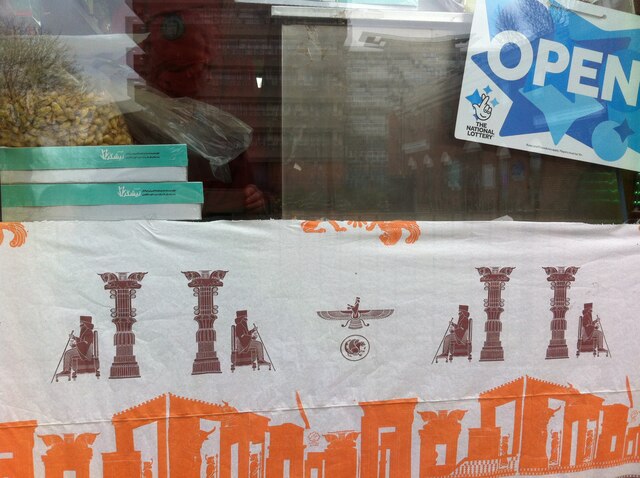Persepolis paper in window of Iranian delicatessen, Hillfields, Coventry
Introduction
The photograph on this page of Persepolis paper in window of Iranian delicatessen, Hillfields, Coventry by A J Paxton as part of the Geograph project.
The Geograph project started in 2005 with the aim of publishing, organising and preserving representative images for every square kilometre of Great Britain, Ireland and the Isle of Man.
There are currently over 7.5m images from over 14,400 individuals and you can help contribute to the project by visiting https://www.geograph.org.uk

Image: © A J Paxton Taken: 19 Mar 2019
This is a detail from the window display of the Persian Mini Market delicatessen in Victoria Street that appears in this geograph Image], though from a photo taken over two years earlier; the paper has since become very faded. It was taken on the 19th March, and the shop and its customers were busy preparing for Nowruz, the Iranian New Year, which is celebrated at the spring equinox. The paper is printed with repeating patterns showing the ruins of Persepolis, the royal palace complex built by the kings of the Achaemenid dynasty of the 6th to 4th century BCE, and burned down by Alexander of Macedon ('Alexander the Great') during his conquest of Persia in 331BCE. Persepolis is the Greek name; it was known to Persians as Parsa, and is called Takht-e-Jamshid (the throne of Jamshid) by modern Iranians. The ruins still stand in the vicinity of the city of Shiraz and are an important non-Islamic symbol of Iranian identity, as is the figure on the winged disc in the centre of the pattern, known today as the Faravahar. At Persepolis this represented either kingly glory ('khvarenah') or the god Ahuramazda, and as a modern symbol of Zoroastrian religion and Iranian culture it is often identified with the fravashi or personal spirit. See Curtis J, Sarikhani Sandmann, I & Stanley, T, Epic Iran: 5000 Years of Culture, V&A Publishing, 2021, pp62-65, also the Wikipedia article on the Faravahar here https://en.wikipedia.org/wiki/Faravahar .

